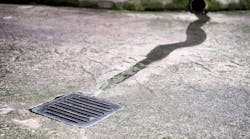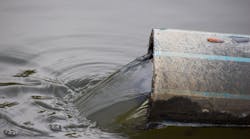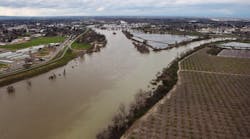A product designed to filter stormwater makes use of cartridges filled with different types of media, geared to treat the specific pollutant loadings of each site.
The StormFilter?, made by Stormwater Management Inc., can remove high levels of stormwater pollutants like sediments, oil and grease, soluble heavy metals, organics, and soluble nutrients. It is a stormwater filtration Best Management Practice designed to meet local, state and federal requirements of the National Pollution Discharge Elimination System.
The filtering systems design began with the development of a filter media produced from processed autumn leaves. It was demonstrated that the system is effective for treatment of both first flush flows and slower-paced flows during the latter part of a storm.
The StormFilter is a passive, flow-through stormwater filtration system made up of vaults that contain rechargeable cartridges filled with filter media. The filtering systems are installed in-line with storm drains. Stormwater passes through media-filled cartridges, which trap particulates and adsorb materials such as dissolved metals and hydrocarbons. After passing through the media, the stormwater flows into a collection pipe or discharges into an open-channel drainage way.
The system is offered in three different configurations: cast-in-place, precast, and linear. The precast and linear models utilize premanufactured vaults. The cast-in-place units are customized for larger flows and may be either covered or uncovered underground units.
A basic precast StormFilter is made of an inlet bay, flow spreader, cartridge bay, overflow and outlet bay. The inlet bay serves as a grit chamber and provides for flow transition into the cartridge bay. The flow spreader acts as a baffle to trap floatables, oils, and surface scum before the water enters the cartridge bay. The filter is designed with an inline overflow that operates when the inflow rate is greater than the design capacity of the system. Stormwater enters the cartridge bay through the flow spreader, cascades over an energy dissipater and begins to pond and percolate horizontally through the media contained in the filter cartridge.
How the Cartridges Work
Each filter cartridge plugged into the underdrain manifold is about 19 inches tall and 19 inches in diameter. As stormwater moves through the media, it begins to fill the center drainage tube since the float is in a closed position. The air displaced by the water is purged out of the one-way air relief valve in the cartridge cap. Once the center tube is filled with water, the buoyant force on the float lifts it from the ball seat and allows the treated water to flow into the underdrain manifold. As the treated water drains, it tries to pull in air behind it, which causes the air relief valve to close. The flowing water then sets up a vacuum siphon that draws polluted water through the filter media.
How the Cartridges Work
The filter cartridge will continue to draw water throughout the storm. At some point during the storm, the water surface elevation in the vault will begin to drop. This continues until the level reaches the lower lip of the hood. At this time, the suction head will quickly draw air into the hood, causing high energy turbulence between the inner surface of the hood and the outer surface of the filter media. This turbulence scrubs accumulated sediments from the surface of the media, causing the sediments to settle to the vault floor. This scrubbing action partially restores the permeability of the media.
How the Cartridges Work
The cartridges can be used with various types of filtration media, like Zeolite, CSF? leaf media, perlite and fabric inserts, which can be used individually or in combination. The media in the cartridges can be altered as a site matures or land use changes.
About the Media
Perlite is a naturally occurring "puffed" volcanic ash. This material is commonly used as a water filtration media. It is effective for removal of fine particles. Perlites extreme porosity and high surface area allow it to act like a sponge and physically capture free oils and greases as they flow across its surface.
About the Media
Zeolites are naturally occurring minerals that have been used in a variety of applications to filter water. Their primary benefit is the removal of anions, as well as cations, from stormwater runoff. Removal of soluble heavy metals, such as lead, copper and zinc ions, is done by the cation exchange capacity of the zeolite. A modified zeolite is now available which has the ability to remove anionic pollutants such as nitrates and ortho (soluble) phosphorus. The individual zeolite granules have been modified to reverse the surface charge (to a positive charge) which electrostatically attracts negatively-charged ions. For ortho phosphorus, the maximum adsorption capacity is about 400 mg/kg.
About the Media
CSF? leaf media is made from a feed stock of pure deciduous leaves that have been turned into a mature stable compost. The compost is processed into an odorless pelletized media. Once complete, the media has physical and chemical characteristics desirable for the filtration of stormwater. The media can perform mechanical filtration to remove sediments, chemical processes to remove soluble heavy metals, and adsorption to remove oils and greases. Removal of sediments can be as high as 95 percent. Soluble heavy metals such as lead, copper and zinc are removed by cation exchange from the medias humic substances, which are produced by the aerobic biological activity that occurs during composting. Measured removal rates of oil and grease are as high as 85 percent.
About the Media
Fabric inserts are designed to be used in conjunction with other types of media for more effective pollutant removal. Their primary purpose is sediment control. The inserts are constructed of durable polyester fabrics which are removable and washable.
About the Media
Vaults can be cast in linear configuration for street drains or parking lots. StormFilters in this configuration can be used in place of catch basins. The systems traffic-bearing lids allow access for maintenance in parking lot installations. Other places where the systems can be used include major roadways and bridge decks, large commercial developments, and large industrial applications.
About the Media
Maintenance on the system involves changing the spent cartridges and removing sediments from the vault bottom. The manufacturer offers system sizing and cost information, as well as help with system design, included in the total price of the filtering system. The company also offers maintenance services.


